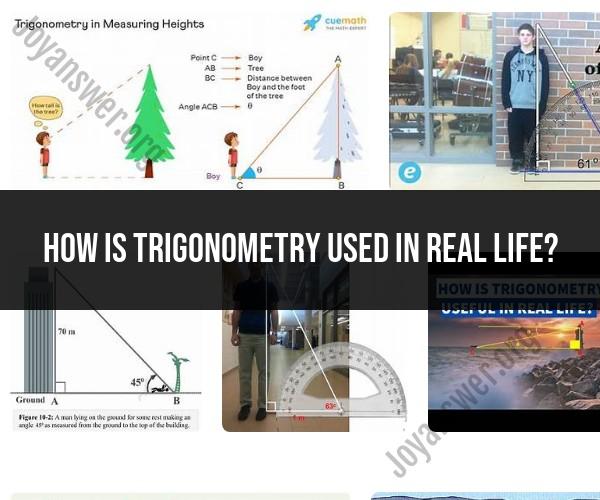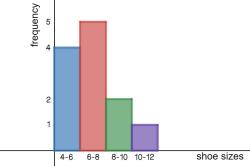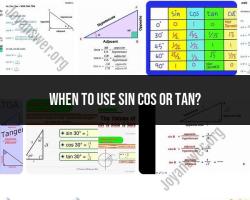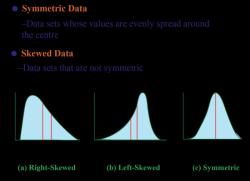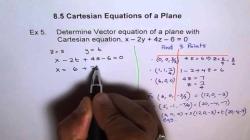How is trigonometry used in real life?
Trigonometry is a branch of mathematics that deals with the relationships between the angles and sides of triangles. It has numerous practical applications in various real-world fields. Here are some common areas where trigonometry is used:
Architecture and Construction:
- Architects and builders use trigonometry to design and construct buildings. Trigonometric principles help in measuring angles, distances, and heights. Roof slopes, foundation stability, and other structural elements are designed using trigonometric calculations.
Surveying and Geomatics:
- Land surveyors rely on trigonometry to measure distances and angles between points on the Earth's surface. This information is crucial for mapping, property boundaries, and construction projects.
Physics and Engineering:
- Trigonometry plays a significant role in physics and engineering, where it's used to analyze and calculate various mechanical, electrical, and structural phenomena. For example, trigonometric functions are used to understand oscillations, waves, and harmonic motion.
Navigation and Geography:
- Trigonometry is fundamental in navigation and geography. Pilots and sailors use trigonometric principles to calculate distances, courses, and angles. GPS systems also rely on trigonometry to determine your location.
Astronomy:
- Astronomers use trigonometry to calculate distances between celestial objects, determine the positions of stars and planets, and analyze the motion of objects in space.
Art and Design:
- Artists and designers use trigonometry to create visual effects, perspective, and compositions. It helps in determining proportions, angles, and dimensions to create realistic or aesthetically pleasing artworks.
Computer Graphics and Animation:
- Trigonometry is essential for computer graphics and animation, enabling the creation of 2D and 3D images. It's used to calculate angles, rotations, and positions of objects in digital environments.
Music and Sound Engineering:
- Trigonometry is involved in understanding sound waves, harmonics, and the mathematical relationships behind musical notes. It's used in musical theory, sound engineering, and the design of musical instruments.
Construction and Mechanical Engineering:
- Trigonometry helps engineers design and analyze mechanical systems, including gears, pulleys, and levers. It's used in calculating forces, torques, and the movement of machinery.
Telecommunications and Signal Processing:
- Trigonometric functions are employed in the analysis and processing of signals, such as in telecommunications and audio processing. They are used to modulate, demodulate, and filter signals.
Healthcare and Medical Imaging:
- Medical imaging technologies like X-ray, MRI, and CT scans rely on trigonometry to create accurate images of the human body. Trigonometric principles are used in image reconstruction and interpretation.
Oceanography and Meteorology:
- Scientists in these fields use trigonometry to measure ocean depths, wave heights, and atmospheric phenomena. It helps in understanding climate patterns and predicting weather events.
Carpentry and Woodworking:
- Carpenters and woodworkers use trigonometry to create precision-cut angles, design joinery, and ensure that structures are level and stable.
These are just a few examples of the many practical applications of trigonometry in the real world. Its ability to solve problems related to angles, distances, and waves makes it an indispensable tool in various scientific, technical, and artistic disciplines.
Trigonometry in Real Life: Practical Applications and Examples
Trigonometry is a branch of mathematics that deals with the relationships between the sides and angles of triangles. It is used in a wide variety of real-life applications, including:
- Engineering and architecture: Trigonometry is used to design and build structures, such as bridges, buildings, and airplanes. It is also used to calculate the forces that act on these structures.
- Navigation, astronomy, and geography: Trigonometry is used to determine location, calculate distances, and navigate from one point to another. It is also used to study the motions of planets and stars.
- Construction and surveying: Trigonometry is used to lay out foundations, measure land areas, and calculate the heights of buildings.
- Modern technology and science: Trigonometry is used in a variety of modern technologies, such as GPS systems, medical imaging devices, and computer graphics.
The Role of Trigonometry in Engineering and Architecture
Trigonometry is essential for engineering and architecture. It is used to design and build structures, such as bridges, buildings, and airplanes. It is also used to calculate the forces that act on these structures.
For example, engineers use trigonometry to design bridges that can support heavy loads. They also use trigonometry to calculate the forces that act on an airplane as it flies.
Architects use trigonometry to design buildings that are both aesthetically pleasing and structurally sound. They also use trigonometry to calculate the amount of sunlight that will enter a building.
Trigonometry in Navigation, Astronomy, and Geography
Trigonometry is used in navigation, astronomy, and geography to determine location, calculate distances, and navigate from one point to another. It is also used to study the motions of planets and stars.
For example, navigators use trigonometry to determine their location at sea. They also use trigonometry to calculate the distance to a destination.
Astronomers use trigonometry to study the motions of planets and stars. They also use trigonometry to calculate the distances to other galaxies.
Geographers use trigonometry to create maps and to calculate the areas of land.
Everyday Uses of Trigonometry in Construction and Surveying
Trigonometry is used in construction and surveying to lay out foundations, measure land areas, and calculate the heights of buildings.
For example, construction workers use trigonometry to lay out the foundation for a building. They also use trigonometry to calculate the heights of buildings and other structures.
Surveyors use trigonometry to measure land areas and to create maps.
The Relevance of Trigonometry in Modern Technology and Science
Trigonometry is used in a variety of modern technologies, such as GPS systems, medical imaging devices, and computer graphics.
For example, GPS systems use trigonometry to determine the location of a device. Medical imaging devices, such as MRI machines and CAT scanners, use trigonometry to create images of the inside of the body. Computer graphics use trigonometry to create realistic images and animations.
Trigonometry is a powerful tool that is used in a wide variety of real-world applications. It is an essential skill for engineers, architects, navigators, astronomers, geographers, and other professionals in many different fields.
